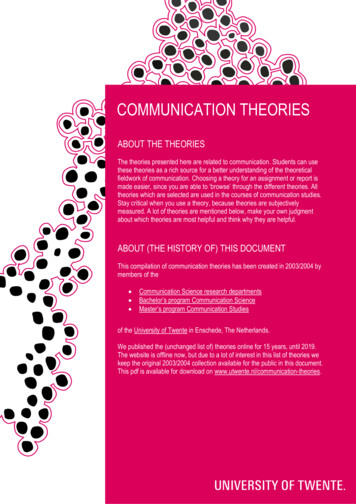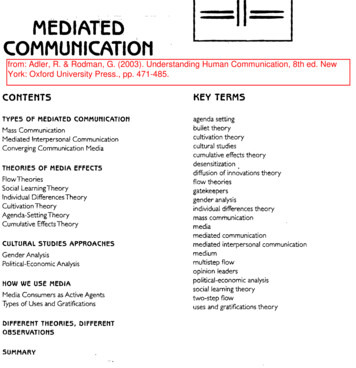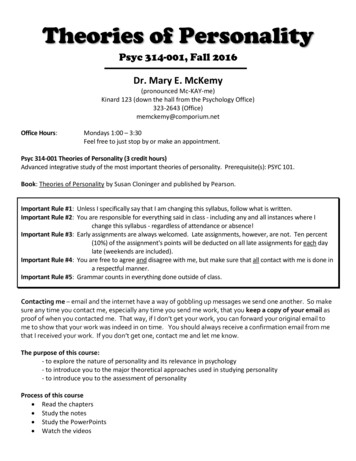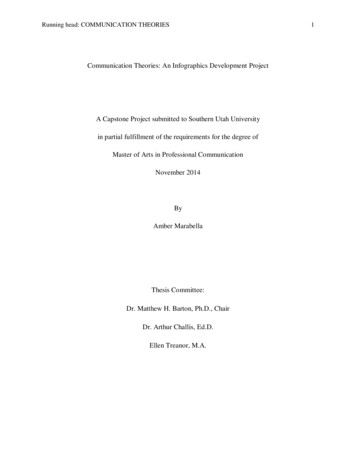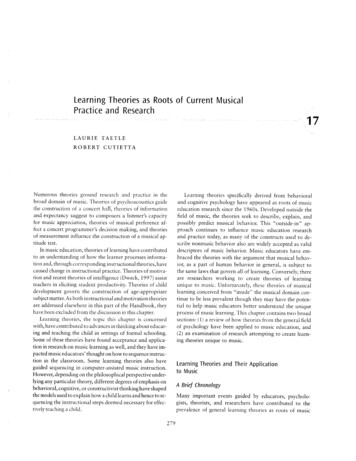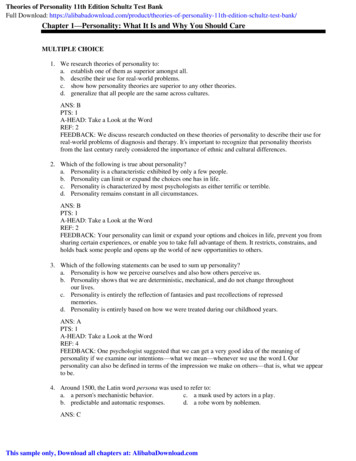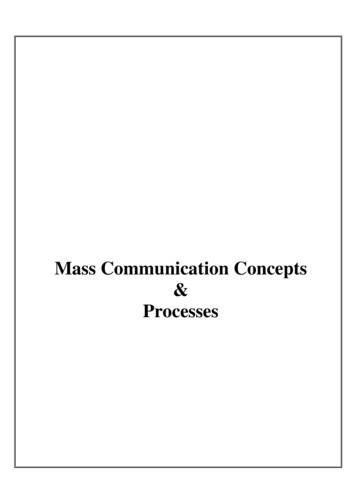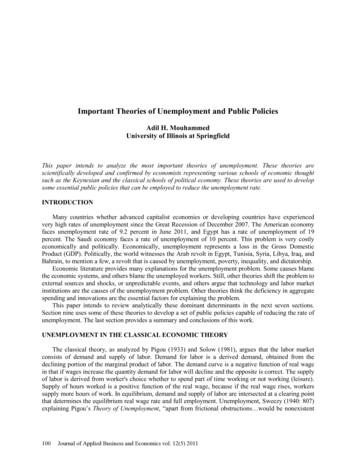
Transcription
Important Theories of Unemployment and Public PoliciesAdil H. MouhammedUniversity of Illinois at SpringfieldThis paper intends to analyze the most important theories of unemployment. These theories arescientifically developed and confirmed by economists representing various schools of economic thoughtsuch as the Keynesian and the classical schools of political economy. These theories are used to developsome essential public policies that can be employed to reduce the unemployment rate.INTRODUCTIONMany countries whether advanced capitalist economies or developing countries have experiencedvery high rates of unemployment since the Great Recession of December 2007. The American economyfaces unemployment rate of 9.2 percent in June 2011, and Egypt has a rate of unemployment of 19percent. The Saudi economy faces a rate of unemployment of 10 percent. This problem is very costlyeconomically and politically. Economically, unemployment represents a loss in the Gross DomesticProduct (GDP). Politically, the world witnesses the Arab revolt in Egypt, Tunisia, Syria, Libya, Iraq, andBahrain, to mention a few, a revolt that is caused by unemployment, poverty, inequality, and dictatorship.Economic literature provides many explanations for the unemployment problem. Some causes blamethe economic systems, and others blame the unemployed workers. Still, other theories shift the problem toexternal sources and shocks, or unpredictable events, and others argue that technology and labor marketinstitutions are the causes of the unemployment problem. Other theories think the deficiency in aggregatespending and innovations are the essential factors for explaining the problem.This paper intends to review analytically these dominant determinants in the next seven sections.Section nine uses some of these theories to develop a set of public policies capable of reducing the rate ofunemployment. The last section provides a summary and conclusions of this work.UNEMPLOYMENT IN THE CLASSICAL ECONOMIC THEORYThe classical theory, as analyzed by Pigou (1933) and Solow (1981), argues that the labor marketconsists of demand and supply of labor. Demand for labor is a derived demand, obtained from thedeclining portion of the marginal product of labor. The demand curve is a negative function of real wagein that if wages increase the quantity demand for labor will decline and the opposite is correct. The supplyof labor is derived from worker's choice whether to spend part of time working or not working (leisure).Supply of hours worked is a positive function of the real wage, because if the real wage rises, workerssupply more hours of work. In equilibrium, demand and supply of labor are intersected at a clearing pointthat determines the equilibrium real wage rate and full employment. Unemployment, Sweezy (1940: 807)explaining Pigou’s Theory of Unemployment, “apart from frictional obstructions would be nonexistent100Journal of Applied Business and Economics vol. 12(5) 2011
if it were not for the fact that wage-earners habitually stipulate for a rate of wages higher than the‘equilibrium’ level.”Full employment does not mean that there is no unemployment. Still frictional unemployment doesexist at the going real wage rate. For example, if a worker thinks that the disutility of work is greater thanthe benefit of work or the utility of the real wage, this worker will decide not to work. This type ofunemployment is called voluntary unemployment. Frictional unemployment arises because of thedynamic nature of the labor markets, the availability of information, the search for better jobs, andrandom fluctuations in demand for labor such as closing of a plant and of opening of a new plant.Duration of frictional unemployment is determined by the unemployment insurance benefits and thespeed of the information.Wicksell thinks that if wages are sufficiently flexible downward, then this decline can maintain fullemployment (Jonung 1989: 28-35). Cheaper credit to businessmen is the most effective measure to fightunemployment. He even thought that the government should support private investment in housing andsoils. Government can support the introduction of various inventions as well. Government support shouldbe financed by taxation. Wicksell analyzes technical unemployment due to technological change as well.The introduction of machinery would cause unemployment but the unemployed will search for new jobs,a search that will push wages downward. Hence, full employment is restored again. For the normal(frictional) unemployment, Wicksell thinks that advertisements and employment agencies can reduce thenormal rate of unemployment. The cyclical unemployment, as another type of unemployment, is due tothe lack of effective demand. He though it would be a good idea to raise wages in order for workers tobuy more. But this action may cause workers to lose their jobs as a result of higher wages.Essentially, for Wicksell the cyclical unemployment was due to the wrong investment of capital.Capital was invested in areas where rates of return were low. He concluded that public works is the bestmeasure to fight cyclical unemployment. After World War I, Wicksell thinks the boom and the rise inprices induced by the war would come to an end. Thus, unemployment would rise. Workers would haveto accept lower wages. He also thought that government should provide financial support to theunemployed who could not find jobs. After 1921, Wicksell turns to Malthus. He thought that the causesof the unemployment are the surplus people, shortage of capital brought about by the war, and thedisorganized state of the monetary system. For the third cause, after the war prices were falling andproducers decided to produce lower amounts of production because they knew they would receive lowerprices for their products. Thus, they let their money set idle in banks and workers became unemployed.These causes suggest that emigration became one of the important policies for solving the unemploymentproblem.Wage reduction is not a competent policy to increase employment. The increase in wages is mostlikely due to increased labor productivity and wage reduction will reduce work intensity and productivity.Wage reduction will not force some capital intensive firms to switch to labor intensive techniques in theshort run. Higher wages should stimulate the substitution effect by employing more machines for labor.And this substitution will increase labor productivity and employment in the long-run.Hayek (Nishhiyama and Leube 1984: 7) contends that unemployment is due “to a discrepancybetween the distribution of labor between industries and the distribution of demand among theirproducers. This discrepancy is caused by a distortion of the system of relative prices and wages.” In otherwords, the unemployment is caused by “a deviation from the equilibrium prices and wages which wouldestablish themselves with a free market and stable money.” This is actually a mismatch between demandand supply of labor, which is usually caused by expansionary monetary and fiscal policies and powerfultrade unions. These policies create economic dislocation and structural changes in an economy whichmisdirect labor and other economic resources to other alternatives. Unions are also able to set higherwages compared to market wages, which generate unemployment, particularly in industries that becomeless profitable. In short, for Hayek the unemployment problem is caused by resources being in the wrongplaces at the wrong time and can be corrected if wages and prices are determined by the equilibrium ofsupply and demand.Journal of Applied Business and Economics vol. 12(5) 2011101
In line with Hayek theory of unemployment, Trehan (2001) provides an important explanation of thesearch theory of unemployment. Firms search for the productive workers and workers search for highpaying jobs. So, both agents continue searching until matches are reached. At that point a worker willleave the unemployment pool. But if a worker realizes later on that her productivity is worth higher wagesand firms are paying high wages on the average, then the worker’s reservation wage will increase.Consequently, the unemployment rate will start rising gradually, indicating a mismatch has occurredagain.UNEMPLOYMENT IN THE THEORY OF INNOVATIONSOriginally, this theory was developed by the German economist Von Mangoldt (Ekelund and Hebert2007) wrote a book about entrepreneurial profits in 1855 and connected profits to risk. He providedseveral ways by which the entrepreneur can make profits. These ways are (1) finding particular markets,(2) acquisition of productive agents, (3) skillful combination of factors of production, (4) successful salespolicy, and (5) innovations. And it is well understood proposition that entrepreneurial profits will increaseemployment (Mouhammed 2010).Schumpeter (1934) does not provide explicitly a theory of unemployment but his theory of thebusiness cycle does demonstrate clearly how unemployment can be reduced. Innovation (see also Vecchi1995) which creates more jobs relative to job destruction is the basic force beyond the increases inemployment and the decreases in unemployment. When entrepreneurs innovate something new such asthe production of a new product, the finding of a new market, the finding of a new method of production,and the introduction of new technologies and a new organization they increase investments to materializethose innovations. Domestic investment expenditures will increase demand on economic resources andwill increase their prices. Other entrepreneurs will imitate the leaders by adopting the new innovations.Labor and materials will be employed to produce the new items. Consequently, wages will be increasingand unemployment will be declining, assuming that employment creation will outweigh employmentdestruction due to the new innovations (see also Mortensen and Pissarides 1998 and Manuelli 2000).Schumpeter started his analysis by explaining economic development. By development, which is theessential part of his endogenous dynamic economics, Schumpeter (1934: 83) means the “changes ineconomic life as are not forced upon it from without but arise by its own initiative, from within. Should itturn out that there are no such changes arising in the economic sphere itself, and that the phenomenon thatwe call economic development is in practice simply founded upon the fact that the data change and thatthe economy continuously adapts itself to them, then we should say that there is no economicdevelopment.” Economic development which reflects new changes outlined below is not a phenomenonthat can be explained by economic forces only, but it has to be explained by other forces that are externalto the ones analyzed by economic theory.For Schumpeter, economic development generates changes in the socio-economic environment,including the existing equilibrium. As he (1934: 64) puts it: “Development .is spontaneous anddiscontinuous change in the channels of the flow, disturbance of equilibrium, which forever alters anddisplaces the equilibrium state previously existing.” The essential driving force for generatingdevelopment is innovations introduced by the entrepreneurs whose leadership becomes the triggeringdevice for the discontinuous dynamic changes. Innovations start by “the producer [not consumer] who asa rule initiates economic change, and consumers are educated by him if necessary” (Schumpeter 1934:65). It follows that economic development is defined “by the carrying out of new combinations” whichare triggered by the business entrepreneur and appeared discontinuously (Schumpeter 1934: 66). And theoutcomes of these combinations are welcomed by the consumers who are affected by the entrepreneurialleadership. That is, leadership becomes the prime mover to consumers and other imitating producers.The concept of innovation which creates changes according to Schumpeter (1934: 66) covers thefollowing five areas of development: “(1) the introduction of new good.or of a new quality of a good. (2)The introduction of a new method of production.(3) The opening of a new market.(4) The conquest ofa new source of supply of raw materials, or manufactured goods.(5) The carrying out of the new102Journal of Applied Business and Economics vol. 12(5) 2011
organization of any industry, like the creation of a monopoly position.or the breaking up of a monopolyposition.” The new combinations are usually embodied in new productive enterprises which start byutilizing the unemployed working people, the unsold raw materials, the new technologies, and the unusedproductive capacity. As Schumpeter (1934: 68) points out, “Development consists primarily in employingexisting resources in a different way, in doing new things with them, irrespective of whether thoseresources increase or not.”For the continuation of the process of economic development and innovations credit and finance areimportant requirements: “in carrying out new combinations, financing.is fundamentally necessary”(Schumpeter 1934: 70). Credit is a very important function in economic development because it providesfunds for the entrepreneurs to materialize innovations, or to carry out the new combination. Consequently,Schumpeter (1934: 74) argues, the banker who has savings and creates the money (or the purchasingpower) for the entrepreneur is “a phenomenon of development.”Accordingly, entrepreneurial leadership which triggers the process of economic development is “aspecial kind of function and in contrast to a mere difference in rank, which would exist in every socialbody” (Schumpeter 1934: 87). Leadership arises “only where new possibilities present,” and innovationsrequire leadership, and the entrepreneur is the leader who responds to reality effectively and creatively.For her efforts, the entrepreneur earns entrepreneurial profits as a surplus over costs. That is, newcombinations are carried out if there is development and if total receipts are greater than the total costs.Most importantly, Schumpeter (1934: 154) contends, “without development there is no profit, withoutprofit [there is] no development.” And without profit there is no accumulation of wealth under capitalism.In other words, entrepreneurial leadership becomes the essential driving force for the business enterprisesand the backbone of competitive capitalism.Not only does economic development generate employment, income, and profits, but it also createsthe value of land (rent), and without development the value of land does not exist. As the process ofdevelopment continues the land value will rise due to urban and rural expansion. Moreover, developmentcreates demand for certain goods. This is called repercussion of development, which creates surpluses(Schumpeter 1934: 172). Hence, profits are augmented in the process of the repercussion of development,which will in turn create another price for credit which is called the interest rate. Interests will be paid outof the profit or the surplus value. It is also true that without development there is no interest, but theprocess of development makes interest act “as a tax upon profit” (Schumpeter 1934: 175). ForSchumpeter, supply and demand for credit will determine the interest rate, where the demand for credits isdiscontinuous because innovations are discontinuous. In short, higher wages and employment, economicprofit, interests, and rents are all phenomena generated by innovations which in turn furnished by theentrepreneur.During the process of economic development the economy is drifted toward a boom which isfollowed by a downturn, or a recession. Schumpeter contends that during the early period of theprosperity phase of the business cycle, the new innovating firms generate a higher demand for economicresources which must come from other industries. However, an innovative firm means it is able toproduce per unit of a product at a smaller cost (Schumpeter 1928: 378). At the same time the innovativefirms start selling the new products at reasonable prices, reflecting the economic power of theseinnovative enterprises. Given the low cost of production, the reasonable prices will generate higherrevenues and surpluses which include profit.The profit, however, is a temporary phenomenon. This is because some older firms become adaptedto the new conditions and innovations and will be able to imitate (or copy) the methods and the productsof the leading innovative enterprises. On the one hand, demand for economic resources will rise, so willtheir prices and the cost of production. Cost per unit of output will increase. On the other hand, the largevolume of production will lower the prices, as firms lose their economic power for setting higher pricesfor their products. Consequently, as costs rise and revenues decline, profits will be eliminated, andliquidation will follow. Pessimism emerges and the capitalist economy moves toward a recession or adepression. Revival will start again after new swarms of innovations are initiated by some entrepreneurs.Journal of Applied Business and Economics vol. 12(5) 2011103
Business enterprises whose leaders are creative will establish their economic power again for settinghigher prices for low cost production. Profits will be rising, so will investments and employment.Essentially, Schumpeter’s theories of economic development and the business cycle are based on theentrepreneur and her creative leadership and responses. Schumpeter emphasizes the fact that innovationmeans creative destruction, destroying old products, firms, and markets and creating new products, firms,markets, and technologies that generate secondary waves. Innovation is a matter of entrepreneurialleadership and individual initiatives (Schumpeter 1928: 384). The entrepreneurial creative responses,Schumpeter (1947: 150) argues, are not predictable but are generating significant changes for a longperiod of time. Hence, entrepreneurship according to Schumpeter (1947: 151) is the mechanism ofeconomic change, and the entrepreneur is the one who gets things done and controls the resistance anddifficulties facing her business operations. In fact, the entrepreneur is the force behind economic andinstitutional changes such as technologies, products, contracts, property, labor relations, regulations,security, and freedom.UNEMPLOYMENT IN THE THEORY OF EFFECTIVE DEMANDVeblen points out that the volume of output is set to attain a satisfactory profit and is a manifestationof the predatory instinct of the vested interests which aim at domestic and international dominance. Buthow is this volume of production determined to achieve reasonable profits? Veblen gives a lucid answer.He accurately realizes, and before Lord Keynes reaches a similar conclusion, that vested interestsdetermine the volume of output after taking into consideration the aggregate demand. As Veblen (1904:195) explains:In part by actual increase of demand and in part through a lively anticipation of anadvanced demand, aggressive business enterprise extends its venture".And the 'venture', of course, means extending production and operations, assuming the existence of areasonable level of profits.The level of aggregate demand will provide the necessary increases in total revenues. On the otherside, the cost of production has to decline. If revenue rises and cost declines, then the reasonable level ofprofits can be found. There are various forces in Veblen’s work that reduce the cost of production.Technology increases production and reduce the cost of inputs used in the production process, andenterprises cut wages and increase productivity in order to cut cost per unit of output. Better technologycan reduce the prices of capital goods, and government can cut taxes. Banks can reduce the interest ratesas well. Administrative and insurance cost can be declined in order to stimulate business enterprises. Thedecline in costs, given rising revenues, will increase the profit level for Veblen. Consequently, higherprofits will force the business enterprises to expand and employ more workers. Thus, employment willincrease and the rate of unemployment will decline.Keynes (1936) considers unemployment as an involuntary phenomenon. He thinks that employmentis cyclical, generated by the deficiency of aggregate demand (Mouhammed 2010). Capitalists hireworkers and invest to produce output when the expectations about the economy and profits are favorable.If expectations about the future are supported by reality, investments and employment continue risinguntil equilibrium is reached. This equilibrium is attained by the intersection of the aggregate demand andsupply--the point of the effective demand—which may be less than the full employment equilibrium. Ifexpectations about the future of the economy are not favorable, capitalists invest less and employ lessnumber of workers. Hence, the equilibrium is achieved where cyclical unemployment exists. Thisunemployment is due to the deficiency of the aggregate demand, particularly investment expenditures.Consistent with Keynes’s teaching, Davidson (1998), a representative of Post Keynesian economics,argues that involuntary unemployment is explained by insufficiency of effective demand, instability ofexchange rates, and international mobility of finances which create uncertainty that weakensentrepreneurial confidence to make investments to reduce unemployment. Similarly, other Keynesians104Journal of Applied Business and Economics vol. 12(5) 2011
argue that the unemployment is due to the contractionary nature of the U.S. monetary policy whichcreates deficiency in aggregate demand. Other Keynesians think that the unexpected increase in pricelevel, or a higher rate of inflation, will reduce the real wage and increase demand for labor. That is, therate of unemployment will decline. This idea reminds one with the old proposition of Phillips curvesuggesting there is a trade-off between the rate of unemployment and the rate of inflation.UNEMPLOYMENT IN THE REAL BUSINESS CYCLE THEORYIt is argued in this theory (Chatterjee 1995 and 1999) that the growth of productivity of input whichrevolutionizes technology is the main source of employment and unemployment. If the growth of outputincreases more than the growth of inputs, then total factor productivity or the residual, has increased. Iftotal factor productivity is not growing, then firms and the economy become inefficient. It follows thatreallocation of labor and capital cannot be achieved and labor and capital will be used in less profitableopportunities.There are various causes for the slowdown in total factor productivity. Technology is not improvingin the production of goods and services and workers’ skills are not being enhanced. New products are notinvented and when the prices of imported materials are increasing. Once total factor productivity isstagnating, the co-movements in other important variables will slowdown. For example, consumptionexpenditures will not increase above the trend, nor will investment spending. GDP and total hours workedwill not be above the trend either. When consumption, investment, GDP, and hours of work decline, theSolow’s residual, which represents the growth in labor productivity and is measured by the differencebetween actual and predicted productivity growth (or shocks), will decline. That is, there is noimprovement in technology and productivity under this condition. Therefore, unemployment willincrease.Technology shocks are brought about by scientific and engineering development, by R&D,management techniques, and by industrial organizations that make inputs more productive. InSchumpeter’s terminology innovations are being introduced and are very effective in making theeconomy grow. Innovations and favorable technological shocks also reduce inputs and increase totalfactor productivity. In short, if shocks to productivity brought about by technological shocks do not exit,the unemployment will rise.Gali and Rabanal (2004) contend that demand and monetary shocks affect the variables of thebusiness cycle, including employment, by about 75 percent, where the technological shocks affect thosevariables by about 25 percent. Gali (1999) finds that the positive shocks in technology generate a declinein hours of labor and negative comovement between technology shocks and productivity. For him, nontechnology shocks generated positive comovement between hours and productivity. His results were notconsistent with the real business cycle theory.UNEMPLOYMENT AND PRODUCTIVITYThe standard microeconomic theory produces a similar result with different terminology. In thistheory the marginal revenue product is MRP which is the multiplication of marginal revenue (MR) by themarginal product of labor (MPL), or productivity. Mathematically, it is MRPL (MR) (MPL). And theprofit-maximizing firm will hire workers until MRPL W, where W is the given wage rate. It is assumedthat the production function is of the form where output (Q) depends on two resources Labor (L) and allother resources combined as O, and is subject to a constant return to scale, where the sum of theexponents of L and O is equal to one. It is also assumed that the production function is affected by thetechnological level A such that,Q ALaOb 1Journal of Applied Business and Economics vol. 12(5) 2011105
Differentiate the production function partially with respect to labor yields Q/ L aALa-1Ob 2Use the marginal product of labor in the MRPL equation to obtainMRPL MR x MP MR x (aALa-1Ob) 3because,MPL (aALa-1Ob)The MRPL should equal to the real wage rate W/P, where P is the price of the product. The MRPL is equalto the value of the marginal product of labor if MR P under perfect competition. Under imperfectcompetition, the MRPL is smaller than the value of the marginal product, indicating the existence of laborexploitation. In any event, solving for L, we obtain the employment levelL aPQ/W .4where PQ represents the gross domestic product, or GDP. If the numerator and the denominator of theabove equation are divided by L, one can obtainL aPQ/L/W/L a (average product of labor)/(average wage)This equation states that if labor productivity (or the average product of labor) increases, assuming Wis constant, the demand for labor, L, will rise, and the unemployment rate will decline. And this shift (orincrease) in the demand for labor can occur, for example, if investment or capital formation increases.This is because if labor productivity increases relative to wages, the employer or the producer willincrease the firm’s rate of profit by hiring more workers (L).The previous analysis was adopted by Arthur Lewis (1954). Lewis develops what was called theLewis model in which he assumes that if there was a surplus of labor and a given demand for labor, thenthe wage rate is fixed. Lewis points out that under this condition capitalists do make a certain level ofprofit. The capitalists will reinvest part of the profits in new capitals. This investment will raise laborproductivity. Hence, the demand for labor will increase, and these new employed workers can come fromlow productivity sectors or the rural areas. This increase in employment will provide more profits for thecapitalists, and more profits will increase investment, employment, and income. In short, demand forlabor will shift to the right when labor productivity rises, indicating an increase in employment andincome.Clearly, the introduction of new innovative marketing techniques will increase the demand for theproduct and consequently will increase demand for labor. Moreover, if productivity increases due to agreater utilization of capital goods, new technological advances, and better quality of labor (due toeducation, training, and health), then the demand for labor (or employment) will increase. In other words,successful innovations will increase productivity and employment (Schumpeter 1934). In addition, if theprices of capital goods decline, the quantity demanded for these goods will rise. Consequently, output willincrease, so will the employment of labor. If resources are complement, the employment of more capitalin the production process will increase the demand for labor or employment.In fact, technological change or growth will be equal to the growth rate of output minus the growthrate of labor productivity. If productivity increases significantly, it will increase the growth rate of thegross domestic product (GDP) with larger increases than productivity, which forces employers at thatpoint to hire more workers to accommodate expected demand. Wages will rise but if labor productivityincreases at a rate faster than the increase in wages, then the rates of inflation and unemployment willdecline.106Journal of Applied Business and Economics vol. 12(5) 2011
MARKET STRUCTURE AND UNEMPLOYMENTMicroeconomic theory contends that market structure does affect the level of unemployment. Underthe perfect competitive market the demand for labor and the supply of labor intersects to determine thewage rate and employment. Under this market condition, the demand for labor reflects labor productivity.Employers will hire workers up to the point where the value of marginal product (VMPL MPL X P) isequal to the wage rate. Let us call this employment level Ec.Under imperfect market conditions the outcomes are different. The demand for labor reflects themarginal revenue product (MRPL MPL X MRX), where MRX is the marginal revenue. Under thiscondition, MRX is lower than the market price P. It follows that the MRPL is lower than VMPL. That is,there is exploitation of the labor force by employers. The second important outcome under the imperfectmarket condition is that the marginal labor cost will be above the labor supply. When the MRPL intersectsthe marginal factor cost, the employment of labor (Em) is determined. But t
2007) wrote a book about entrepreneurial profits in 1855 and connected profits to risk. He provided several ways by which the entrepreneur can make profits. These ways are (1) finding particular markets, (2) acquisition of productive agents, (3) skillful combination of factors of production, (4) successful sales policy, and (5) innovations.
